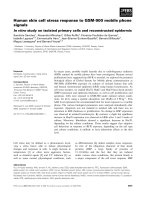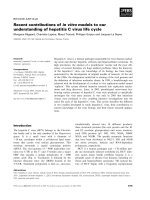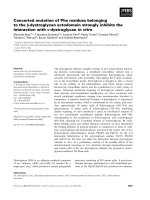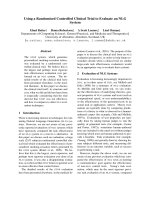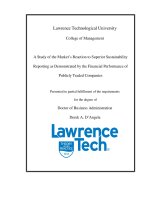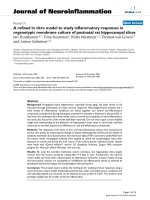A preliminary in vitro study to evaluate Poly-3-Hydroxy butyrate as an anticoccidial agent against oocysts of E. tenella
Bạn đang xem bản rút gọn của tài liệu. Xem và tải ngay bản đầy đủ của tài liệu tại đây (439.72 KB, 9 trang )
Int.J.Curr.Microbiol.App.Sci (2018) 7(8): 4364-4372
International Journal of Current Microbiology and Applied Sciences
ISSN: 2319-7706 Volume 7 Number 08 (2018)
Journal homepage:
Original Research Article
/>
A Preliminary in vitro Study to Evaluate Poly-3-Hydroxy Butyrate as an
Anticoccidial Agent against Oocysts of E. tenella
T. Aadithya1, S. Meignanalakshmi1*, M. Raman2, M. Parthiban1 and K. Vijayarani1
1
Department of Animal Biotechnology, Madras Veterinary College, TANUVAS,
Chennai-7, India
2
Translational Research Platform for Veterinary Biologicals, MadhavaramMilk Colony,
TANUVAS, Chennai-51, India
*Corresponding author
ABSTRACT
Keywords
Coccidiosis,
Sporulation
inhibition, TEM and
SEM analysis,
E. tenella oocyst,
PHB
Article Info
Accepted:
26 July 2018
Available Online:
10 August 2018
The present study was conducted to evaluate the effect of Poly-3-Hydroxy
butyrate against the sporulation of oocyst of E. tenella. In this study four
different doses of PHB which was extracted from the Bacillus subtilis
culture, 10, 20, 50and 100mg were used with 2.5% potassium dichromate
as positive control and distilled water as negative control. The experiment
was carried out in 24 well plates. The sporulation efficiency was evaluated
by counting the sporulated and unsporulated oocysts using haemocytometer
and percentage efficiency of sporulation inhibition was calculated. Data
were analysed using chi square test. The PHB at 100mg concentration
showed significant effect on sporulation inhibition when compared to other
doses of PHB and positive control.
Introduction
Coccidiosis is the major parasitic disease
which causes serious threat to the poultry
industry. It is caused by the Apicomplexan
protozoa called as Eimeria which consists of
many species which affects the poultry either
individually or in combination. Severe
outbreaks resulted in tremendous economic
loss due to increased morbidity and mortality.
The genus Eimeria most commonly affects
the intestinal tract, thereby affects the
intestinal epithelium which inturn leads to
reduced feed efficiency and body weight gain
(Min et al., 2004; Dalloul and Lillehoj, 2005).
The most common species of Eimeria which
affects poultry industry was E. tenella, E.
acervulina and E. maxima. Coccidiosis is
mainly caused by the ingestion of sporulated
oocysts which will be able to survive in the
environment for several months. This disease
is mainly controlled by the use of some
chemotherapeutic
agents
and
some
anticoccidial chemicals. Due to extensive and
4364
Int.J.Curr.Microbiol.App.Sci (2018) 7(8): 4364-4372
indiscriminate use of anticoccidial drugs in
poultry industry leads to the development of
drug resistance against all the drugs. Despite
the global acceptance and success of these
drugs in controlling avian coccidiosis, the
poultry industry is under constant pressure to
reduce the dependence on anticoccidial drugs
(Williams, 1999). These problem become
public health concern about the presence of
drug residues in poultry products which made
the industry to look for the alternatives.
Although various natural products were used
for controlling coccidiosis, still none of the
studies were repeated and not led to large
scale applications of any of these compounds
in practice. Inspite of all these drawbacks,
associated with control strategies still there is
need for alternatives. Poly-3-Hydroxy
Butyrate which is a biopolymer produced by
various groups of bacteria, a neutraceutical
compound which was used as a feed additive
as well as it suppress or inhibit the pathogenic
bacteria in GI (Gastro intestinal) tract such as
E.coli, Vibrio, Salmonella and it also has
antimicrobial activity (Singh and Parmar,
2011). The attractive features such as
Biocompatibility, biodegradability and non
toxicity which renewed the interest of using
this as an alternative source. Hence in the
present study PHB (Poly-3-hydroxy butyrate)
was evaluated for its effect against E. tenella
oocyst in terms of sporulation inhibition and
cell wall integrity (Fig. 1).
Materials and Method
Collection of faecal sample for recovery of
oocyst
Fresh faecal droppings were collected from
Translational Research Platform in Veterinary
Biologicals animal shed, Madhavaram Milk
Colony, Chennai-51. About 50-100g of fresh
faecal sample was collected from the E.
tenella oocyst challenged birds.
Processing of faecal sample
The faecal sample of about 25-30 grams were
weighed and mixed with 75-100ml of distilled
water. The suspension was mixed thoroughly
and stained using double layer of nylon sieve
with pore size approximately 1mm and filtrate
was transferred into 50ml Falcon tubes
(Tarson, India) and centrifuged at 3000 rpm
for 10mins. The supernatant was discarded
after centrifugation and saturated salt solution
was added to the pellet and left for few
minutes for the oocyst to reach the top and
5ml of the supernatant was taken in a new
50ml tube and 30ml of distilled water was
added and centrifuged at 3000 rpm for 10min.
The above step was repeated 3-5 times to
remove all the salt solution. Final pellet was
mixed with water and the oocyst count were
eneumerated using McMaster counting
chamber (Long et al., 1986).
Extraction of PHB from Bacillus spp
Preparation of NDMM medium
For the production of PHB by Bacillus spp
NDMM medium was used. The NDMM
Medium was prepared by using the following
constituents such as Dextrose (5g), Sodium
chloride (0.05g), Magnesium sulphate
(0.05g), Potassium dihydrogen phosphate
(0.125g), Peptone (1.25g), Yeast extract
(1.25g) and distilled water (500ml) (Panigrahi
and Badveli, 2013).
The medium was prepared for 2500ml and
was autoclaved at 121ºC for 20 mins at 15lbs
pressure to avoid contamination. After
autoclaving, Bacillus spp culture was added
into the medium at the rate of 25ml per 500ml
of medium.
Large scale production of PHB from Bacillus
spp was carried out using Bioreactor.
4365
Int.J.Curr.Microbiol.App.Sci (2018) 7(8): 4364-4372
Extraction of PHB from NDMM medium
PHB was extracted using the dispersion
method of sodium hypochlorite and
chloroform (Singh and Parmar, 2011) with
minor modifications.
In vitro anticoccidial activity of PHB
against oocyst of E. tenella
The oocyst of E. tenella collected from fresh
faecal sample was used for in vitro study. In
vitro evaluation was performed as per the
protocol described by (Mikail et al., 2016). In
vitro evaluation was performed in 24 well
plates to study the sporulation inhibition
efficiency of the compound.
The study was conducted using PHB at
different doses 10mg, 20mg, 50mg and
100mg
and
Amprolium
1mg
(anticoccidiostat), 2.5% potassium dichromate
was taken as positive control and oocyst
suspension as negative control.
The sporulated and unsporulatedoocyst were
counted at 0, 24 and 48 hours using
haemocytometer. Each treatment contains
≤50,000 oocyst.
Evaluation of PHB against cell wall
integrity of oocyst
Four doses of PHB were taken 10, 20, 50 and
100 mg with amprolium as positive control
and 2.5% potassium dichromate as negative
control. Amprolium was taken at the rate of
1g/ml. Approximately 10µl of sample was
taken and diluted with water and added to 24
well plates with different doses of PHB,
positive and negative control.
All the samples were maintained at room
temperature and observed for lysis of cell wall
after 48 hours. The cell wall integrity was
assessed by subjecting the sample to SEM and
TEM analysis.
Transmission Electron Microscope (TEM)
analysis of PHB (100mg) treated E.
tenellaoocyst
TEM analysis was carried out at Centralised
Instrumentation
Laboratory,
Madras
Veterinary College, Chennai-7. A drop of
PHB treated oocyst suspension was pipetted
onto the specimen plug for Transmission
Electron Microscope. The mounted specimens
were placed in an incubator and allowed to
dry. The plug containing PHB (100mg)
treated oocyst was examined by Transmission
Electron Microscope. Photographs were made
with a polaroid camera.
Scanning Electron Microscope (SEM)
analysis of PHB (100mg) treated E.
tenellaoocyst
SEM analysis of PHB (100mg) treated E.
tenella oocyst was carried out at the
Department of Mechanical Engineering, Anna
University, Guindy. A drop of PHB (100mg)
treated oocyst suspension was pipetted onto a
specimen plug for the scanning electron
microscope, and allowed to air dry. Mounted
specimens were placed in. a vacuum
evaporator and coated with a layer of gold,
100 Å thick. The plug containing coated
oocysts was placed in a Japanese Scanning
Microscope
(JSM-2)
and
examined.
Photographs were made with a polaroid
camera.
Statistical analysis
Both sporulated and unsporulated oocyst was
counted and sporulation inhibiting percentage
at 0, 24 and 48 hours were, calculated,
tabulated and statistical analysis was carried
out. The data were analysed by one way
ANOVA.
Results and Discussion
4366
Int.J.Curr.Microbiol.App.Sci (2018) 7(8): 4364-4372
Different doses of PHB showed dose
dependent inhibition for the sporulation of E.
tenella oocysts as compared to the control
group (2.5% Potassium dichromate). The
statistical analysis showed that the doe of
100mg PHB inhibits the sporulation to certain
extent followed by 50mg of PHB.
Different doses of PHB showed dose
dependent inhibition of sporulation of E.
tenella oocysts as compared to Positive
control groups (K2Cr2O7) and negative control
group (Oocyst suspension). It can be seen
from the Table 1a–1d 91.4% of oocysts of E.
tenella managed to sporulate in the control
incubations containing K2Cr2O7 (Positive
control) and oocyst suspension (Negative
Control) whereas in incubation containing 10,
20, 50 and 100mg of PHB 86%, 81%, 74%
and 68% of the oocyst were able to sporulate
at 48 hrs. The maximum sporulation of
Eimeria spp differs between the species. The
different dose of PHB showed maximum
inhibition at 100mg followed by 50mg, 20mg
and 10mg respectively when compared to
control groups. The sporulation inhibition of
E. tenella oocyst treated with PHB at 0, 24
and 48 hrs is given in the Table 1d.
Transmission
Electron
Microscopic
analysis of PHB (100mg) treated E. tenella
oocyst
E. tenella oocyst treated with 100mg of PHB
analysed by TEM (Fig. 2) revealed shrinkage
in the proteinaceous layer of micropylar area.
Scanning Electron Microscope analysis of
PHB treated E. tenella oocyst
SEM analysis of PHB treated E. tenella
oocyst showed Breakage at the outer
proteinaceous wall of oocyst is shown in the
Figure 3.
Table.1a The effect of PHB on sporulation inhibition of E. tenella oocyst at 0 hours
Dose
of
compound
PHB(10mg)
the Sporulated oocysts Unsporulated
Percentage
of Percentage
of
oocysts (n=6) (Mean unsporulated oocysts sporulated oocysts
(n=6) (Mean ±SD)
±SD)
2666±1032
47000±2097
94.63
5.37
PHB(20mg)
2666±1032
47666.66±1505
94.70
5.30
PHB(50mg)
2333 ±816
48333±1505
95.39
4.61
PHB(100mg)
2333 ±816
46666±1632
95.20
4.8
Amprolium(1mg)
2333 ±816
47333±2065
95.30
4.70
Positive control
2333±816
48333±1505
95.39
4.61
Negative control
2333±816
48333±1505
95.39
4.61
Positive Control- 2.5% Potassium Dichromate. Negative control- Oocyst suspension. Each treatment contains ≤
50,000 oocyst
4367
Int.J.Curr.Microbiol.App.Sci (2018) 7(8): 4364-4372
Unsporulate
d oocysts
(n=6)
(Mean ±SD)
Percentage
of
unsporulated
oocysts
Percentage
of sporulated
oocysts
26000±1786
28666±1632
23333±1632
19000±1095
27333.33±1032
46000±1264
35000±2097
22333.83±1505
22000±1264
26666±1032
31666.66±1505
23000±2097
4333.33±1505
14333.33±1505
46.20
45.42
53.33
62.40
54.30
8.60
29.05
53.80
54.58
46.67
37.60
37.60
91.40
70.95
P value
Significance
between the
groups
Sporulated
oocysts (n=6)
(Mean ±SD)
PHB(10mg)
PHB(20mg)
PHB(50mg)
PHB(100mg)
Amprolium (1mg)
Positive control
Negative control
F value
between the
groups
Dose of the
compound
Table.1b The effect of PHB on sporulation inhibition of E. tenella oocyst at 24 hours
53.998
.000**
Positive Control- 2.5% Potassium Dichromate. Negative control- Oocyst suspension. Each treatment contains ≤
50,000 oocyst.
** Indicates highly significant. ** P ≤ 0.001 between the groups indicates highly significant.
Table.1c The effect of PHB on sporulation inhibition of E. tenella oocyst at 48
Hours
Dose
of
compound
PHB(10mg)
PHB(20mg)
the Sporulated oocysts Unsporulated
Percentage of Percentage
(n=6) (Mean ±SD) oocysts
(n=6) unsporulated
of
(Mean ±SD)
oocysts
sporulated
oocysts
43333±1032
7000±1095
13.90
86.10
39666±1505
9333±1032
19.00
81.00
PHB(50mg)
PHB(100mg)
Amprolium(1mg)
Positive control
Negative control
F value between the
treatments
P value Significance
between the groups
37666±1505
33000±2097
36000±1786
46000±1264
42000±1264
134.813
13000±2756
15333±1632
13666±2943
4333±1505
8333±1505
25.65
31.70
27.51
8.60
16.56
74.35
68.30
72.49
91.40
83.44
.000**
Positive Control- 2.5% Potassium Dichromate. Negative control- Oocyst suspension. Each treatment contains ≤
50,000 oocyst.
** Indicates highly significant.
** P ≤ 0.001 between the groups indicates highly significant.
4368
Int.J.Curr.Microbiol.App.Sci (2018) 7(8): 4364-4372
Table.1d The effect of PHB on sporulation of E .tenella oocysts at 0, 24 and 48 hours
Dose
of
compound
the Percentage
sporulation
inhibition
‘’0’’ hours
94.63
PHB(10mg)
94.70
PHB(20mg)
95.39
PHB(50mg)
95.20
PHB(100mg)
Amprolium(1mg) 95.30
95.39
Positive control
95.39
Negative control
of Percentage
sporulation
at inhibition
‘’24’’ hours
46.20
45.42
53.33
62.40
54.30
29.05
29.05
of Percentage
sporulation
at inhibition
‘’48’’ hours
13.90
19.00
25.65
31.70
27.51
8.60
8.60
of
at
Positive Control- 2.5% Potassium Dichromate. Negative control- Oocyst suspension. Each treatment contains ≤
50,000 oocyst.
Figure.1 Photomicrograph of Sporulated and unsporulated oocyst of E. tenella (400X)
SPORULATED OOCYST
UNSPORULATED OOCYST
Figure.2 Transmission Electron Micrograph (TEM) of PHB (100mg) treated E. tenella oocyst at
48hrs at 3000X
SHRINKAGE
AND
SMALL CIRCULAR
DEPRESSION
NOTICED IN THE
OUTER
PROTEINACEOUS
LAYER
OF
MICROPYLAR
AREA
4369
Figure 1a: Transmission Electron Micrograph (TEM) of PHB
(100mg) treated E.tenellaoocyst at 48hrs at 3000X.
Int.J.Curr.Microbiol.App.Sci (2018) 7(8): 4364-4372
Figure.3 Scanning Electron Micrograph (SEM) of PHB (100mg) 48hrs treated oocyst at 3000X
BREAKAGE OF OOCYST
OOCURS AT THE
MICROPYLAR LAYER
OF PROTEINACEOUS
WALL OF OOCYST
NORMAL OOCYST
WITHOUT ANY
DAMAGE
The drugs which can inhibit sporulation
process are the best choice as preventive
mechanisms against coccidiosis. Due to the
lack of effective and non-toxic disinfectants
against coccidian and recent restriction of
coccidiostatic drugs in poultry production,
lead to the search for safe and effective
alternatives for controlling coccidiosis.
Various studies have been carried out to study
the sporulation inhibition by using various
products. In the present study, the polymer
PHB was used at different doses (10, 20, 50
and 100mg) against the sporulation of E.
tenella oocyst. The present study showed dose
dependent inhibition of sporulation of E.
tenella oocyst. At the dose rate of 100mg of
PHB inhibited the sporulation at 62.40%
followed by 50mg, 20mg and 10mg of PHB
inhibited at 53.33%, 46.20% and 45.42%
respectively, when compared to the Positive
control and negative control, 8.60% and
29.05% respectively.
Hanan et al., (2009) conducted a trial using
Xenorhabdus and Photorhabdus spp on
sporulation of Eimeria oocyst and reported
promising results for controlling the Eimeria
in deep litter system. Remmal et al., (2013)
used essential oil components against the
chicken Eimeria oocyst and the number of
oocyst decreased with 20mg/ml of essential
oil. In the present study the sporulation was
inhibited at 100mg of PHB followed by
50mg, 20mg and 10mg of PHB when
compared to control groups. Similar results
were by Zaman et al., (2015). They
performed an experiment using herbal
extracts against Eimeria tenella oocyst and
found out that these herbal extracts exhibited
anti-sporulation effect by interfering in the
physiological
process
necessary
for
sporulation. These extracts inhibited the
sporulation at dose dependent manner from
500µg to 0.244 µg/ml.
Jitviriyanon et al., (2016) used various
essential oils collected from indigenous plants
against the oocyst of E. tenella. Out of
various oils, only two essential oils from B.
pandurata and O. basilicum showed
inhibition effect on sporulation of oocyst
when compared with the positive control. By
Comparing the present study with various
studies of other products the PHB produced
4370
Int.J.Curr.Microbiol.App.Sci (2018) 7(8): 4364-4372
by Bacillus spp was shown
sporulation inhibition effect.
to
have
References
Mikail et al., (2016) studied the anticoccidial
activity of Methanolic extract of leaves of
Lanneaschimperi against E. tenella oocyst.
He studied the efficacy of these products
against the cell wall of oocyst and found out
that extracts at higher concentration (100mg)
showed more efficacy on the lysis of cell wall
of oocyst followed by 50mg and 25mg
concentration when compared to the control
groups. 100mg of extracts inhibited
sporulation at 98% followed by 50mg and
25mg with sporulation inhibition at 89% and
68% respectively. The oocyst of coccidia are
very resistant to physical and chemical
treatment because of the presence of the two
proteinaceous layers on its walls derived from
the coalescence of wall forming bodies found
in the macrogamete stage of parasite (Belli et
al., 2006). The present study revealed that
PHB could be used to break the oocyst which
was more helpful in controlling as well as
preventing coccidiosis which is causing major
economic loss to the poultry industry.
PHB extracted from Bacillus spp inhibited the
sporulation of E. tenella oocyst under invitro
condition
Conflict of interest
None declared
Acknowledgment
The work designed was carried out for the
award of M.V.Sc degree in Animal
Biotechnology in the academic year 2016–
2018. The author wishes to thank the Tamil
Nadu Veterinary and Animal Sciences
University for funding the entire research
project and Department of Animal
Biotechnology for providing all assistance
with equipment and chemicals
4371
Belli, S.I., N.C. Smith and Ferguson, D.J.P.
2006. The coccidian oocyst: a tough nut
to crack. Trends parasitol22: 416-423.
Dalloul, R. Aand Lillehoj. H. S. 2005. Recent
advances in immunomodulation and
vaccination
strategies
against
coccidiosis. Avian Dis. 49:1–8.
Hanan, A., E. Sadawy, M. Rabab, E. Khateeb
and Kutkat, A.M. 2009. A Preliminary
InVitro Trial on the Efficacy of
Products
of
Xenorhabdus
and
Photorhabdus Spp. on Eimeria Oocyst.
Glob. Vet.3(6): 489-494.
Jitviriyanon, S., P. Phanthong, P. Lomarat, N.
Bunyapraphatsara, S. Porntrakulpipat
and N. Paraks. 2016. In vitro study of
anti-coccidial activity of essential oils
from
indigenous
plants
against
Eimeria tenella. VetParasitol, 228: 96–
102.
Long, P. L., J. Johnson, M.E. McKenzie, E.
Perry, M.S. Crane and Murray.P.K,
1986. Immunization of young broiler
chickens with low level infections of
Eimeria tenella, E. acervulina, or E.
maxima. Avian Pathol.15:271–278.
Mikail, H.G., M. Yusuf and Hussain. G,
2016. In vitro Anticoccidial Activity of
Methanolic
Leaves
Extract
of
Lanneaschimperi Against Oocysts of
Eimeria tenella. J Pharm Biol Sci.
11(3): 35-38.
Min, W., R.A Dalloul and Lillehoj, H.S,
2004. Application of biotechnological
tools
for
coccidian
vaccine
development. J. Vet. Sci. 5, 279–288.
Panigrahi, S and Badveli, U,2013. Screening,
Isolation and Quantification of PHBProducing Soil Bacteria. Int J Eng Sci.
2(9):01-06.
Remmal, A., S. Achahbar, L. Bouddine, F.
Chami
and Chami, N, 2013.
Oocysticidal Effect of Essential Oil
Int.J.Curr.Microbiol.App.Sci (2018) 7(8): 4364-4372
Components against Chicken Eimeria
Oocysts. Int J Vet Med. Research &
Reports, Article ID 599816, 8 pages
Singh, P and Parmar, N, 2011. Isolation and
characterization
of
two
novel
polyhydroxybutyrate (PHB)-producing
bacteria. AJB. 10(24): 4907-4919.
Williams, R. B., 1999. A compartmentalised
model for the estimation of the cost of
coccidiosis to the world’s chicken
production industry. Int. J. Parasitol. 29:
1209–1229.
Zaman, M.A., Z. Iqbal, R. Z. Abbas and
Ehtisham-ul-Haque.S, 2015. In vitro
Efficacy of Herbal Extracts against
Eimeria tenella. Int. J. Agric. Biol. 17:
84-89.
How to cite this article:
Aadithya, T., S. Meignanalakshmi, M. Raman, M. Parthiban and Vijayarani, K. 2018. A
Preliminary in vitro Study to Evaluate Poly-3-Hydroxy Butyrate as Anticoccidial Agent against
Oocysts of E. tenella. Int.J.Curr.Microbiol.App.Sci. 7(08): 4364-4372.
doi: />
4372


